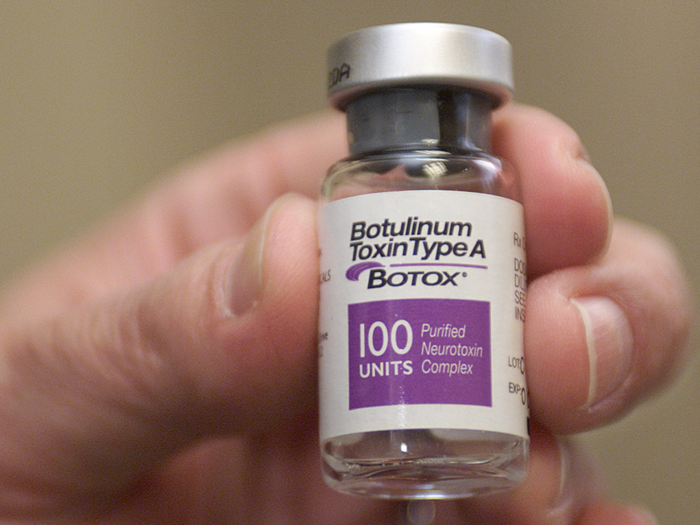
While studying food poisoning in the 1800s, German physician Justinus Kerner realized that there were neurological components to the Clostridium botulinum bacteria which causes botulism, an extreme form of food poisoning that causes difficulty swallowing, muscle weakness, paralysis, and even death if left untreated.
From there, Kerner went on to see if there were any therapeutic effects to the neurotoxins that the bacteria gave off.

During the 1990s, while researchers were exploring all the different ways to use Botox, doctors began to use the drug "off-label" (meaning the FDA has yet to approve it) to smooth out wrinkles temporarily. Botox became so popular that at one point in 1997, the US ran out of its supply, inciting a panic for those using it for off-label wrinkle removal.
Allergan officially got FDA approval for cosmetic Botox to treat glabellar lines (the wrinkles between your eyebrows also known as frown lines) in 2002.

For many years after Kerner's research, botulinum toxin was avoided, in part because there were fears about it getting into the wrong hands and being used as a deadly weapon.
But in 1980, ophthamologist Alan B. Scott started looking into botulinum toxin Type A as a way to treat strabismus, or crossed eyes. By 1987, eye doctors used the neurotoxin to correct these crossed eyes with pretty good results.

Also in the 1980s, eye doctors looked into botulinum toxin's use in another eye condition: blepharospasm, which causes abnormal blinking and tightening of eyes. While treating the eye disorder, the researchers also noticed that wrinkles began to disappear around the injection sites near the eyes. Allergan acquired the rights to botulinum toxin from Scott in 1988, putting it on track for FDA approval and giving it the marketing name Botox.
Botulinum toxin was approved by the FDA to treat strabismus and blepharospasm in 1989.

After its original approvals for those eye conditions, Allergan began to explore what other areas they could treat. By 2000, they had won approval from the FDA to use Botox to treat cervical dystonia, a condition in which the muscles of the neck cause the head to turn a certain way.

While experimenting, researchers began to figure out that Botox could be used on other areas of the body, especially areas in danger of extreme sweating.
In 2004, the FDA approved Botox injections for severe axillary hyperhidrosis, otherwise known as severe underarm sweating, that can't be treated with topical treatments. The Botox works by confusing the nerve endings in the armpit, which keeps the sweat glands from feeling the need to produce sweat.

To be clear: Botox is only approved to treat underarm sweat and doesn't necessarily work on any other areas. But because it's so successful in treating underarm sweating, some women are getting the injections under their hair to keep it from getting too sweaty and frizzy after a particularly strenuous workout. According to FastCompany, it's common for SoulCycle fanatics.

The 2010s have been a good time for Allergan and Botox. The company had already won a number of approvals, and to kick off the decade the company got approval to treat two more medical conditions with Botox. The first was for upper limb spasticity, a condition that affects how you move your arms and causing spasms in those muscles.

Later that year, the FDA approved using Botox to treat chronic migraines, which is defined as having a headache for most days of the month. Migraines can be debilitating pain, often accompanied by other unpleasant symptoms like nausea and sensitivity to light and sound. An injection once every three months can paralyze some of the nerves in the head connected to these migraines.

Since then, the drug proved an effective way to deal with bladder conditions, such as overactive bladder and urinary incontinence, or the involuntary leakage of urine. Botox proved effective, when injected into the bladder muscle, at helping the bladder relax and keeping it from overacting and leaking.

Allergan got its second cosmetic Botox approval in 2013 for use on lateral canthal lines, also known as crows; feet. It's so far the only approved treatment for this kind of wrinkles.

According to Allergan after its recent R&D day, the company has a total of 18 more possible uses for Botox, of which six are already under consideration by the FDA. Some are for therapeutic areas like juvenile cerebral palsy, heart conditions, along with more cosmetic areas.
 Colon cancer rates are rising in young people. If you have two symptoms you should get a colonoscopy, a GI oncologist says.
Colon cancer rates are rising in young people. If you have two symptoms you should get a colonoscopy, a GI oncologist says. I spent $2,000 for 7 nights in a 179-square-foot room on one of the world's largest cruise ships. Take a look inside my cabin.
I spent $2,000 for 7 nights in a 179-square-foot room on one of the world's largest cruise ships. Take a look inside my cabin. An Ambani disruption in OTT: At just ₹1 per day, you can now enjoy ad-free content on JioCinema
An Ambani disruption in OTT: At just ₹1 per day, you can now enjoy ad-free content on JioCinema In second consecutive week of decline, forex kitty drops $2.28 bn to $640.33 bn
In second consecutive week of decline, forex kitty drops $2.28 bn to $640.33 bn
 SBI Life Q4 profit rises 4% to ₹811 crore
SBI Life Q4 profit rises 4% to ₹811 crore
 IMD predicts severe heatwave conditions over East, South Peninsular India for next five days
IMD predicts severe heatwave conditions over East, South Peninsular India for next five days

Copyright © 2024. Times Internet Limited. All rights reserved.For reprint rights. Times Syndication Service.